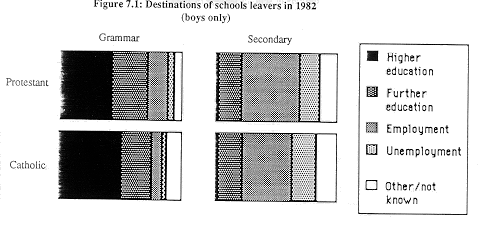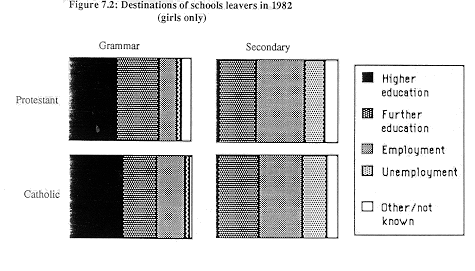Section Seven In 1984 some 27,700 pupils left school. Of this number, just over a third were known to have remained in full-time education, whether in universities, polytechnics, teacher training or further education colleges. Most of the remaining two-thirds or so of school leavers entered the labour market.
Osborne (1985) has provided a breakdown of the destinations of
all school leavers in 1982 by sex and the religious affiliation
of the school attended. Figure 7.1 presents the proportions entering
various destinations for boys from Protestant and Catholic grammar
and secondary schools, while figure 7.2 presents similar information
for girls. The significant proportions of both boys and girls
for whom the post-school destinations were not known should be
noted: clearly this places some limitations on conclusions derived
from these data. The most striking difference in both figures
is that between pupils leaving grammar and secondary schools.
With better academic qualifications, grammar pupils were much
more likely to enter higher or further education. By contrast
secondary school leavers were much more likely to enter the labour
market. However the destinations were unknown for a higher proportion
of the secondary school leavers.

Among grammar school boys, a higher proportion from Catholic schools
entered higher education (ie. university, polytechnic or teacher
training) while somewhat more of those from Protestant schools
entered further education or employment. Among secondary boys
the overall proportions are broadly similar, although those leaving
Protestant schools were somewhat more likely to gain employment.
Among girl leavers from grammar schools the relative proportions
entering higher or further education were similar. The most marked
difference among girls leaving grammar schools was that more from
Catholic schools entered employment. The only other noticeable
difference was in the higher proportion of girls leaving Protestant
grammar schools for whom the destination was unknown.
 Among girl leavers from secondary schools more leaving Protestant schools went into employment, while more leaving Catholic schools were known to be unemployed. For these pupils also, the final destinations were unknown for a higher proportion of the Protestant school leavers.
Two studies published by the Fair Employment Agency (Cormack et
al., 1980, and Murray and Darby, 1978; see also Cormack and Osborne,
1983b, and Murray and Darby, 1983) examined the differential experiences
of pupils leaving Protestant and Catholic secondary schools in
Belfast, Strabane and Derry. More recent information is available
from a cohort study carried out by the Policy, Planning and Research
Unit (PPRU) (McWhirter et al., 1987; McWhirter, 1989). The most striking common finding from the FEA studies was that a higher proportion of the pupils leaving Protestant schools were in employment whereas a high proportion of those leaving Catholic schools were enrolled in Government Training Centres, were unemployed or had decided to return to school. In addition to this a high proportion of the Protestant school leavers in both studies had obtained their employment through family contacts. In the Belfast study this method of gaining employment was also common among the pupils leaving Catholic schools. However, as employment was higher generally among Protestants in the catchment areas of these schools, those pupils leaving Protestant schools were in a more advantageous position to use personal contacts. A further common feature of both studies was the disillusionment of school leavers with education. Before entering the labour market many had been convinced that the possession of some qualifications would enhance their employment opportunities, a hope that for many was not realised. In addition, many of those who finally decided to return to full-time education did so for apparently negative reasons, i.e. because they could not find a job.
The PPRU study involved a cohort of almost 3,000 fifth-formers
from 77 grammar and secondary schools who were followed from 1984
to 1987. McWhirter et al. (1987) reported on the cohort 14-18
months after they had reached school leaving age. At this time
39% were in full-time education, mainly in grammar schools or
other education colleges and a further 10% were engaged in part-time
education. Of the 61% who were economically active, almost two-thirds
were in full-time employment, while 17% were following a YTP course
and an equal proportion were unemployed. Catholics, those with
better educational qualifications and the socially advantaged
were all more likely to remain in full-time education beyond the
school-leaving age. Of those who did chose to leave school, Catholics,
the poorly qualified and the socially disadvantaged were less
likely to have full-time employment. Mc Whirter (1989) reported on the progress of the cohort to December, 1987, by which time the sample were 18 years old. By this stage Protestants were consistently more likely than Catholics to have full-time employment. In the early years of the study there had been little difference in the unemployment rate of Catholics and Protestants, due to the greater proportions of Catholics who stayed in full-time education or entered YTP course. By age 18, however, Catholics were about twice as likely as Protestants to be unemployed. Echoing the findings of Miller (1978), McWhirter found no religious differences in attitudes to work and suggested that the evidence pointed to the unemployed being unemployed by circumstance rather than choice.
McWhirter had found that Protestants were more likely than Catholics
to be employed, irrespective of educational qualifications. Indeed,
while fewer Catholics than Protestants had above average educational
qualifications, these Catholics were still less likely to be in
full-time education than Protestants with below average educational
qualifications. For both Protestants and Catholics in employment,
the most frequently used source for obtaining a job was family
contacts: this source was used more frequently by males than females,
and by those with average or below average educational qualifications.
McWhirter reported few differences in the occupational profiles
of Protestants and Catholics in employment, although slightly
more Protestants were in non-manual occupations.
The PPRU cohort study and DENI school leavers data provide valuable
global information on the post-school destinations of young people
in Northern Ireland. In addition, more information will come from
the PPRU study in the near future. These data could usefully be
complemented by more detailed investigation of the processes involved
in the move from school to the employment market: it would be
possible, for example, to more directly examine the link between
curriculum, qualifications and employment; another area worth
investigating would be the careers advice provided by schools
to their pupils, and the links between schools and employers.
At the time of writing a Fair Employment Bill is being discussed
in Westminster: in the light of this it is disturbing to note
in the evidence discussed above the continuing prevalence of informal
networks in the employment market. It would be possible to monitor
any effects of the new legislation on these practices.
| |||||